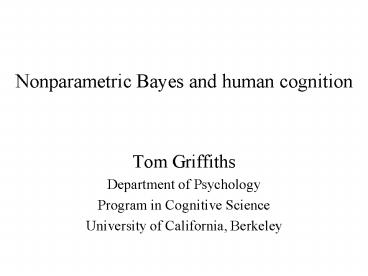Nonparametric Bayes and human cognition PowerPoint PPT Presentation
Title: Nonparametric Bayes and human cognition
1
Nonparametric Bayes and human cognition
- Tom Griffiths
- Department of Psychology
- Program in Cognitive Science
- University of California, Berkeley
2
(No Transcript)
3
Analyzing psychological data
- Dirichlet process mixture models for capturing
individual differences - (Navarro, Griffiths, Steyvers, Lee, 2006)
- Infinite latent feature models
- for features influencing similarity
- (Navarro Griffiths, 2007 2008)
- for features influencing decisions
- ()
4
(No Transcript)
5
Flexible mental representations
- Dirichlet
6
Categorization
- How do people represent categories?
7
Prototypes
cat
cat
cat
cat
cat
(Posner Keele, 1968 Reed, 1972)
8
Exemplars
cat
cat
cat
Store every instance (exemplar) in memory
cat
cat
(Medin Schaffer, 1978 Nosofsky, 1986)
9
Something in between
cat
cat
cat
cat
cat
(Love et al., 2004 Vanpaemel et al., 2005)
10
A computational problem
- Categorization is a classic inductive problem
- data stimulus x
- hypotheses category c
- We can apply Bayes rule
- and choose c such that P(cx) is maximized
11
Density estimation
- We need to estimate some probability
distributions - what is P(c)?
- what is p(xc)?
- Two approaches
- parametric
- nonparametric
- These approaches correspond to prototype and
exemplar models respectively - (Ashby Alfonso-Reese, 1995)
12
Parametric density estimation
- Assume that p(xc) has a simple form,
characterized by parameters ? (indicating the
prototype)
Probability density
x
13
Nonparametric density estimation
Approximate a probability distribution as a
sum of many kernels (one per data point)
estimated function individual kernels true
function
n 10
Probability density
x
14
Something in between
Use a mixture distribution, with more than
one component per data point
mixture distribution mixture components
Probability
x
(Rosseel, 2002)
15
Andersons rational model(Anderson, 1990, 1991)
- Treat category labels like any other feature
- Define a joint distribution p(x,c) on features
using a mixture model, breaking objects into
clusters - Allow the number of clusters to vary
a Dirichlet process mixture model (Neal, 1998
Sanborn et al., 2006)
16
A unifying rational model
- Density estimation is a unifying framework
- a way of viewing models of categorization
- We can go beyond this to define a unifying model
- one model, of which all others are special cases
- Learners can adopt different representations by
adaptively selecting between these cases - Basic tool two interacting levels of clusters
- results from the hierarchical Dirichlet process
- (Teh, Jordan, Beal, Blei, 2004)
17
The hierarchical Dirichlet process
18
A unifying rational model
cluster
exemplar
category
19
HDP,? and Smith Minda (1998)
- HDP,? will automatically infer a representation
using exemplars, prototypes, or something in
between (with ? being learned from the data) - Test on Smith Minda (1998, Experiment 2)
111111 011111 101111 110111 111011 111110 000100
000000 100000 010000 001000 000010 000001 111101
Category A
Category B
20
HDP,? and Smith Minda (1998)
prototype
Probability of A
exemplar
HDP
21
The promise of HDP,
- In HDP,, clusters are shared between categories
- a property of hierarchical Bayesian models
- Learning one category has a direct effect on the
prior on probability densities for the next
category
22
Learning the features of objects
- Most models of human cognition assume objects are
represented in terms of abstract features - What are the features of this object?
- What determines what features we identify?
(Austerweil Griffiths, submitted)
23
(No Transcript)
24
(No Transcript)
25
Binary matrix factorization
?
26
Binary matrix factorization
?
27
The nonparametric approach
- Assume that the total number of features is
unbounded, but only a finite number will be
expressed in any finite dataset
?
Use the Indian buffet process as a prior on Z
(Griffiths Ghahramani, 2006)
28
(Austerweil Griffiths, submitted)
29
An experiment
Training
Testing
Seen
Correlated
Unseen
Factorial
Shuffled
(Austerweil Griffiths, submitted)
30
Results
(Austerweil Griffiths, submitted)
31
Conclusions
- Approaching cognitive problems as computational
problems allows cognitive science and machine
learning to be mutually informative - Machine
32
Credits
- Categorization
- Adam Sanborn
- Kevin Canini
- Dan Navarro
- Learning features
- Joe Austerweil
- MCMC with people
- Adam Sanborn
Computational Cognitive Science
Lab http//cocosci.berkeley.edu/
33
(No Transcript)

